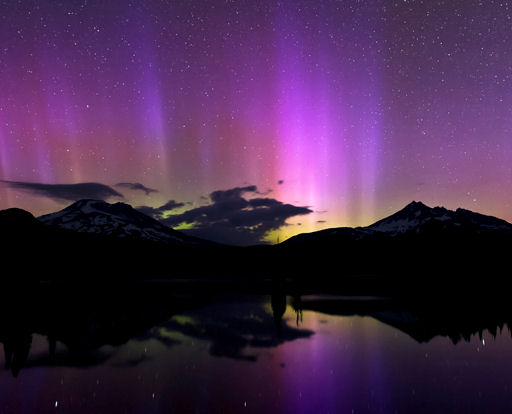GEOMAGNETIC STORM: A strong geomagnetic storm is in progress as Earth's magnetic field reverberates from a CME strike on July 14th. At first the CME's impact seemed relatively weak, but conditions in the wake of the CME have become stormy. Analysts at the Goddard Space Weather Lab say that satellites in geosynchronous orbit may have been directly exposed to solar wind plasma. Also, Northern Lights have appeared in the United States as far south as California, Utah and Nebraska. Aurora alerts: text, voice.
Brad Goldpaint sends this picture of the auroras reflecting from Sparks Lake in central Oregon:
Meanwhile in the southern hemisphere, the aurora australis has been sighted in New Zealand, Australia, and directly above the South Pole itself.

Solar wind
speed: 552.7 km/sec
density: 2.1 protons/cm3
explanation | more data
Updated: Today at 1507 UT
X-ray Solar Flares
6-hr max: C1 0931 UT Jul15
24-hr: C1 0931 UT Jul15
explanation | more data
Updated: Today at: 1500 UT
![]()
Daily Sun: 15 Jul 12
Sunspot 1520 has a delta-class magnetic field that harbors energy for X-class solar flares. Credit: SDO/HMI
![]()
Sunspot number: 120
What is the sunspot number?
Updated 14 Jul 2012
Spotless Days
Current Stretch: 0 days
2012 total: 0 days (0%)
2011 total: 2 days (<1%)
2010 total: 51 days (14%)
2009 total: 260 days (71%)
Since 2004: 821 days
Typical Solar Min: 486 days
Updated 14 Jul 2012
The Radio Sun
10.7 cm flux: 147 sfu
explanation | more data
Updated 14 Jul 2012
![]()
Current Auroral Oval:
Switch to: Europe, USA, New Zealand, Antarctica
Credit: NOAA/POES
![]()
Planetary K-index
Now: Kp= 6 storm
24-hr max: Kp= 6 storm
explanation | more data
Interplanetary Mag. Field
Btotal: 24.1 nT
Bz: 17.3 nT south
explanation | more data
Updated: Today at 1506 UT
![]()
Coronal Holes: 14 Jul 12
There are no large coronal holes on the Earthside of the sun. Credit: SDO/AIA.




